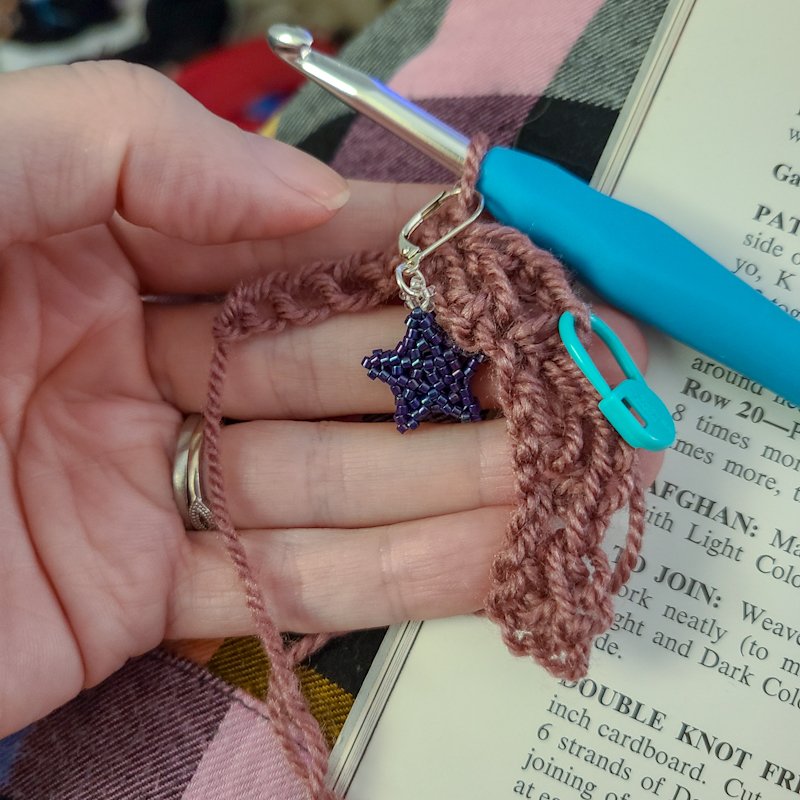Six Ways to Make Knitting Easier with Stitch Markers
If you’ve knit anything in the round or with complex shaping, you’ve probably needed to use stitch markers to help keep your place. But there are a lot of ways you can use extra stitch markers in your knitting to help make it easier to avoid a big mistake, lose your place in the pattern, or just make it a little faster to count stitches.
I didn’t invent any of the below methods; I’ve picked them up from other knitters during my 25 years of knitting. However, I don’t usually see all six of these in one place so I thought I’d write them up for anyone who is looking for some quick and easy ways to smooth their knitting process.
A quick guide to stitch markers
There are three basic types of stitch markers:
Standard stitch markers: these are closed, round loops that slide on to your knitting needle. Once placed the only way to move them is to knit or slip stitches up to the marker and slide it back off. The nice thing about this kind of marker is you can always make extra by tying loops of a contrast yarn.
Removable/locking stitch markers: these markers look and work a little like safety pins. They have a flexible bar that can be hooked closed or unhooked. Unlike standard markers, you can add or remove these from the middle of your knitting at any time. You can also hook them through a stitch instead of the needle to mark a specific stitch or row. Can be used in place of standard stitch markers as well as progress keepers - these little guys are so versatile, it’s worth having some on hand at all times.
Progress keepers: these markers usually have a small lobster claw clasp or other closure that can be opened and closed. They can be used in similar ways to the removable markers to mark specific stitches or rows but don’t always have a large enough opening to be used on the needle as with standard stitch markers.
1. Make casting on large amounts of stitches easier.
I have the hardest time counting cast on stitches if the pattern calls for 100 or more stitches. I have many times double and triple checked my count only to realize in the first few rows of the pattern that I’m one or two stitches off. When I started marking every 50 stitches as I cast on, my cast ons got both more accurate and faster, because I only had to count from the previous marker. This technique works with either removable or standard stitch markers. I generally remove the markers once I have finished the first row of knitting.
2. Mark individual stitches you need to work later.
If you’re knitting a pattern with tuck stitches or any other technique where you need to drop down two or three rows to knit stitches together, release yarn overs or just drop a stitch to create an intentional ladder, it may help to mark either the row you are coming back to or each individual stitch you need to come back to. This also works with crochet patterns – if you need to work a stitch in a particular place in the row below and you’re having trouble seeing where that is, marking the stitch you need to work into can be really helpful (as a relative newbie to crochet, I find doing this on the first few rows of a pattern helps me learn how to “read” the crochet pattern – once I get used to what I’m looking for, I don’t have to continue marking it). Works best with removable markers or progress keepers.
In this example, I needed to do a single crochet into each double crochet in the row below but was having trouble seeing them, so I marked each double crochet as I went along.
3. Mark repeats of stitch patterns.
This technique is particularly useful if you are working a complex or very long repeat – by placing a stitch marker every time the repeat ends, it’s much easier to spot mistakes before you finish a row (if you get to the stitch marker and you aren’t on the last stitch of the repeat, something has clearly gotten off). I know some knitters who swear by this technique so thoroughly that even when the stitch repeat is only four or five stitches, they still mark every single one. I tend to save this for more complex repeats – I never would have been able to finish my Fox Paws scarf (in which the repeats have large numbers of increases and then large numbers of decreases on alternate rows) without this technique. Works with either standard or removable stitch markers.
4. Tracking a series of increases or decreases.
When shaping a sleeve or some shoulder constructions, your pattern might say something like “work decrease row every 5 rows 8 times.” While you can certainly track your progress by using a row counter or making tally marks on a piece of paper, some knitters will instead place a removable stitch marker or progress keeper at the edge of every increase or decrease row, allowing them to not only count to make sure they’ve worked the correct number of rows before the next increase/decrease, but to count how many increases/decreases they’ve worked. Keep in mind that to use this technique correctly you may need to keep a large amount of removeable stitch markers on hand.
5. Picking up stitches evenly.
If you need to pick up a large amount of stitches for a buttonband, sleeve, or collar, the pattern may just say “pick up 104 stitches evenly around neck opening.” One way to help get those stitches even is to use removable stitch markers. Break the total number of stitches down into smaller segments – for example 104 stitches is 4 segments of 26 stitches. Measure the total length of the edge you are picking up from and then break that down to the same number of segments. For example if the neck opening is 8 inches around, 4 segments is 2 inches per segment. Place a removable marker every two inches, pick up 26 stitches between each marker and your stitches should be much more even.
6. Save dropped stitches until you have time to fix them.
We’ve all had that moment where we’ve spotted a dropped stitch several rows down from where we were currently working. Sometimes it’s not a good time to try to ladder down to pick it up, sometimes it will be easier to just secure it later and not bother trying to drop down at all. If you have a removable stitch marker handy, you can quickly secure the loose stitch to one next to it, preventing further laddering until you can decide how you want to fix it. (I don’t recommend most progress keepers for this because they tend to be heavier and can further distort the loose stitch, but they’ll do in a pinch).
Have you used any of these techniques before? Are there other ways you use stitch markers that I haven’t listed here? Let me know in the comments!








